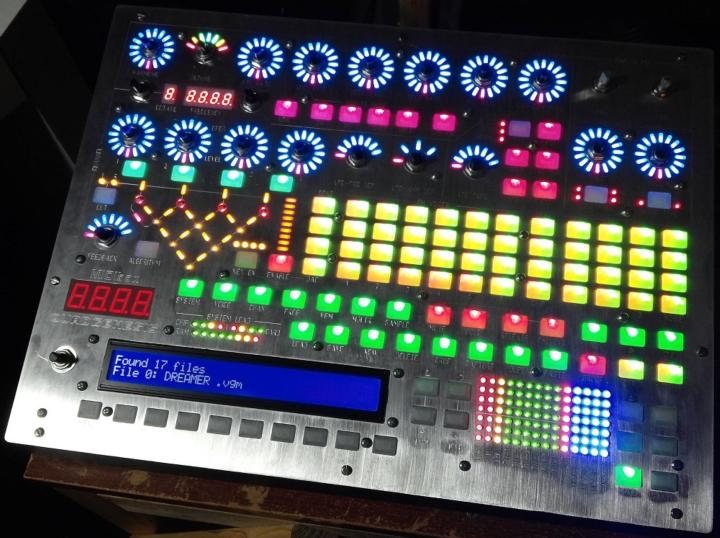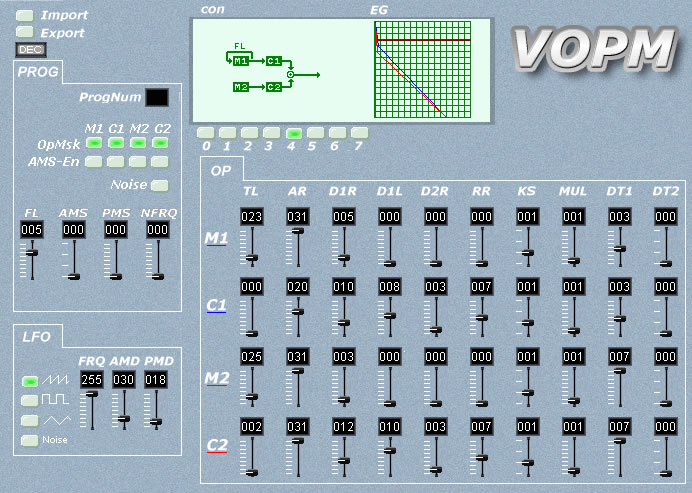Computer Music Chronicles: Modern Chiptune Synthesizers pt.1
US 8 & 16-bit sounds in modern instruments 11/03/24

|
Chiptune is HUGE. As soon as computers started to make bleeps & bloops, people were coding them to produce music. Max Mathew's MUSIC (c. 1957), a monophonic affair, is a little outside the scope of this article, but please leave a comment if you would like me to cover early computer music!
Anyhow, people use all sorts of computers & consoles to create chiptune music. The Amiga is my chosen platform, allowing me to manipulate samples the alongside simple, modulated waveforms, but I've seen folks totally riff out on ZX Spectrums, Commodore 64s and even Game Boys (check out HarleyLikesMusic for instance!)
For many, using original, authentic hardware is key - there are certain effects that require CPU manipulation at audio rates to pull off; e.g lofi sample playback, faux-polyphony and all sorts of SFX sounds, meaning that specialist tracker style programs or custom playback "routines" are required. Check out this ZX Spectrum trying to play back sampled sounds!
Often times, attempts to transplant a soundchip into an accessible instrument, results in reduced complexity - but for synthesizer fans who merely want a "taste" of chiptune, this may not be an issue. Anyhow, enough introductory spiel, onto part 1!
Sega Mega Drive/Genesis
I've recently re-experienced Sega's 16-bit juggernaut in a big way, so it makes sense to start there. The console could be seen as an innovative, cost-reduced variant of it's existing Arcade Hardware. Indeed, much of the console's early hype was built upon notion of "bringing the arcade home". Impactful sights and sounds were the order of the day here - meaning that Sega put quite some effort into the Mega Drive's sound hardware.
The hardware's YM2612 included:
4-operator, 8-algorithm FM with 6 voice polyphony
1 channel of PCM sound - optional PCM playback on the 6th channel - controlled by a Z80 microprocessor, lofi but very useful!
PLUS:
PSG (Programmable Sound Generator) sound module - integrated into the MD's visual display processor, this generated basic square waves & shift register noise. It matched the earlier Sega Master System's audio hardware and, alongside other internal hardware, allowed backwards compatibility with a simple cartridge converter.
Clone Time
There are many ways to get a bit of that Mega Drive Twang in your music. Notably, most of the classic 4OP FM synths (TX81z, TQ5, DX11/21/27) can do a pretty passable imitation of Sega's machine. I even remember a DOS program that allowed you to "rip" 4OP DX patches from Sega "GYM" format music files - though the name escapes me now! Of course, depending on the revision of your childhood console, the DX's might sound a little too classy and refined in the DAC department.
In Software Land, VOPM is a super fun emulation of the sister YM2151 chip, with preset banks of great twangy basses, weird percussion & eery pads. Despite being competent at rolling FM sounds from scratch, I use it all the time as it's super quick to nab a preset and tweak the envelopes to get something quick and satisfying.

Plogue chipsynth MD
Plogue have been heavy-hitters in the world of soundchip emulation for some time now. Their chipsynth MD emulates the original hardware down to the Nth degree:
MD features a bit accurate OPN2 (YM2612) emulator. We combined it with a SN76489-compatible square wave core (SPSG) and a special emulation of the very crunchy sample playback found in games, and we multiplied all of this by 6 to make it polyphonic in every situation imaginable. A complimentary VGM file player allows you to audition hundreds of vintage soundtracks just like they were meant to be heard.
Plogue's reverse-engineering team worked very hard to make sure that even the rarest corner-cases involving the special features of the OPN2 chip were emulated bit-perfectly, backed by large amounts of testing on special hardware rigs. Add the DAC and impulse-response emulation to that, and you get a degree of realism that has never been reached before!

Legendary game composer Yuzo Koshiro even approved of this one; high praise indeed. But what if you're not plugin positive? Well, hardware wise, there's a fair few options too. Let's do some tweaking!
Twisted Electrons MegaFM

This unit is currently out of stock - which must be a good sign! Twisted Electrons specialise in very tweakable hardware synths, many based on retro computers - and the MegaFM is definitely tweakable, with 32 operator faders, 14 knobs and 15 buttons! It doesn't emulate the PCM and PSG elements of the original console - but with TWO voice chips, the FM Polyphony is doubled to 12 voices. This is accessible, malleable FM for those who balk at operator ratios or complex envelopes being programmed via tiny displays!
Sonicware Liven Mega Synthesis
I reviewed this one recently, so you can see my thoughts below. In short, this unit emulates all 3 components of Sega's console: FM, PCM & PSG. There's a variety of "legacy" options to emulate different aspects of the Mega Drive sound and the instrument pushes these sounds in new directions with the addition of operator detuning, a range of effects and LFO's that go up to audio rates! I really enjoyed this one.
Midibox Quad Genesis
Now this one is some kind of wild pipe-dream! This self-build option is mesmerizing to listen to AND look at. Featuring four OPN2 (YM2612) AND four PSG (SN76489/SN76494) chips, the device is designed to perform a number of functions:
The first (paradigm) is the case in which the user has the synth connected to their DAW or to an extension to a tracker, and the user wants to have full control of every sound chip parameter via MIDI (MIDI is supported over USB and UART). This is achieved by setting voices to "Tracker Mode" and assigning channels to control them. The front panel controls will reflect and edit the current voice state, and a short burst of MIDI messages can be dumped back to the DAW which when played back to the synth will restore the voice to the current state. No polyphony, modulators, or other synth engine features are available in this mode.
The second paradigm encompasses the following use cases:
Playing Mega Drive/Genesis VGM files on the synth from the SD card.
"Sampling" VGM files to create custom music–that is, extracting sample, instrument, and control information from VGM files, and then modifying them or playing new music with them.
Creating intricate, custom sounds with FM synthesis and playing them in polyphony across all four sound chips.
The core of the synth engine is a module that plays back many (often over 30) VGM files from RAM in parallel on the eight sound chips. The VGM files being played can be edited down from ones saved on the SD card, and then set up so their commands will be played on different voices based on a dynamic-assignment polyphony engine. In addition, one VGM file at a time may be streamed from the SD card for auditioning or editing. A typical use would be loading and previewing a VGM file from your favorite Mega Drive/Genesis game, using the front panel controls to extract the configuration of a single instrument as a smaller VGM file, creating an instrument out of this new VGM file, and assigning this instrument to a channel to be played on all 24 FM voices in polyphony.
Absolutely genius workflow there! Anyway, I hope you've enjoyed this part 1 of this series. Let us know in the comments what soundchips you'd like us to cover next!
Posted by MagicalSynthAdventure an expert in synthesis technology from last Century and Amiga enthusiast.
< More From: SONICWARE
- Superbooth 2023: SonicWare Texturlab Sounds Only 18-May-23
- Superbooth 2023: Sonicware Introduces LIVEN Texture Lab 12-May-23
- Making Waves On The Sonicware SmplTrek 01-Dec-22
- Sampling on the Sonicware SmplTrek 31-Aug-22
- New Sonicware Groovebox 22-Oct-21
Even more news...
Want Our Newsletter?
More Stories:
More...
Developments for Korg's instrument have been slow but promising.







